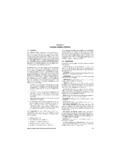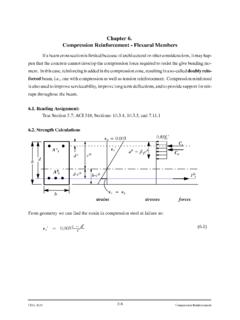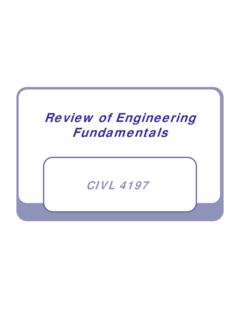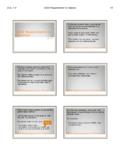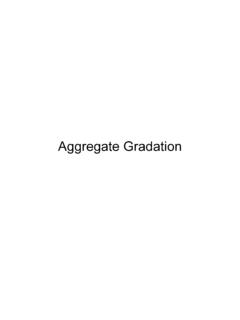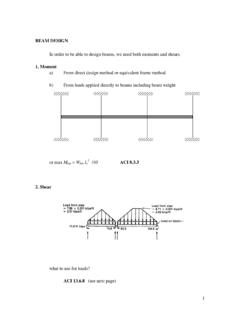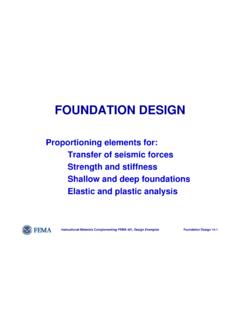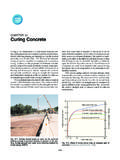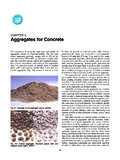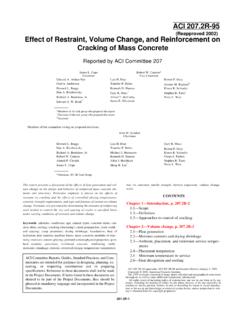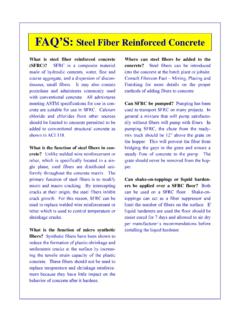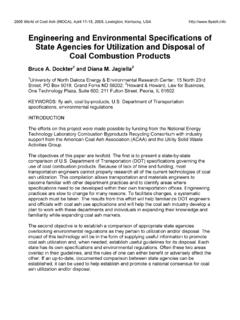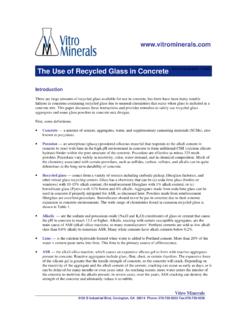Transcription of Designing and Proportioning Normal Concrete …
1 The process of determining required and specifiable char-acteristics of a Concrete mixture is called mix can include: (1) fresh Concrete properties;(2) required mechanical properties of hardened concretesuch as strength and durability requirements; and (3) theinclusion, exclusion, or limits on specific ingredients. Mixdesign leads to the development of a Concrete Proportioning refers to the process of deter-mining the quantities of Concrete ingredients, using localmaterials, to achieve the specified characteristics of theconcrete. A properly proportioned Concrete mix shouldpossess these qualities:1. Acceptable workability of the freshly mixed concrete2. Durability, strength, and uniform appearance of thehardened concrete3. EconomyUnderstanding the basic principles of mixture designis as important as the actual calculations used to establishmix proportions. Only with proper selection of materialsand mixture characteristics can the above qualities beobtained in Concrete construction (Fig.)
2 9-1) (Abrams 1918,Hover 1998, and Shilstone 1990).CHAPTER 9 Designing and Proportioning Normal Concrete MixturesSELECTING MIX CHARACTERISTICSB efore a Concrete mixture can be proportioned, mixturecharacteristics are selected based on the intended use ofthe Concrete , the exposure conditions, the size and shapeof building elements, and the physical properties of theconcrete (such as frost resistance and strength) requiredfor the structure. The characteristics should reflect theneeds of the structure; for example, resistance to chlorideions should be verifiable and the appropriate testmethods the characteristics are selected, the mixture canbe proportioned from field or laboratory data. Since mostof the desirable properties of hardened Concrete dependprimarily upon the quality of the cementitious paste, thefirst step in Proportioning a Concrete mixture is the selec-tion of the appropriate water-cementing materials ratiofor the durability and strength needed.
3 Concrete mixturesshould be kept as simple as possible, as an excessivenumber of ingredients often make a Concrete mixture dif-ficult to control. The Concrete technologist should not,however, overlook the opportunities provided by modernconcrete Materials Ratio andStrength RelationshipStrength (compressive or flexural) is the most universallyused measure for Concrete quality. Although it is an impor-tant characteristic, other properties such as durability, per-meability, and wear resistance are now recognized as beingequal and in some cases more important, especially whenconsidering life-cycle design of the Normal range of strengths used in concreteconstruction, the compressive strength is inversely relatedto the water-cement ratio or water-cementing materialsratio. For fully compacted Concrete made with clean,sound aggregates, the strength and other desirable prop-Fig. 9-1. Trial batching (in-set) verifies that a concretemixture meets design re-quirements prior to use inconstruction.
4 (69899, 70008).149 HOMEPAGES trengthThe specified compressive strength, , at 28 days is thestrength that is expected to be equal to or exceeded by theaverage of any set of three consecutive strength tests. ACI318 requires for to be at least MPa (2500 psi). Noindividual test (average of two cylinders) can be morethan MPa (500 psi) below the specified strength. Spe-cimens must be cured under laboratory conditions for anindividual class of Concrete (ACI 318). Some specificationsallow alternative average strength should equal the specifiedstrength plus an allowance to account for variations inmaterials; variations in methods of mixing, transporting,and placing the Concrete ; and variations in making,curing, and testing Concrete cylinder specimens. Theaverage strength, which is greater than , is called ; itis the strength required in the mix design.
5 Requirementsfor are discussed in detail under Proportioning laterin this chapter. Tables 9-1 and 9-2 show strength require-ments for various exposure of Concrete under given job conditions are governedby the quantity of mixing water used per unit of cement orcementing materials (Abrams 1918). The strength of the cementitious paste binder inconcrete depends on the quality and quantity of thereacting paste components and on the degree to which thehydration reaction has progressed. Concrete becomesstronger with time as long as there is moisture and a favor-able temperature available. Therefore, the strength at anyparticular age is both a function of the original water-cementitious material ratio and the degree to which thecementitious materials have hydrated. The importance ofprompt and thorough curing is easily in Concrete strength for a given water-cementing materials ratio may result from: (1) changes inthe aggregate size, grading, surface texture, shape,strength, and stiffness; (2) differences in types and sourcesof cementing materials; (3) entrained-air content; (4) thepresence of admixtures; and (5) the length of curing and Control of Concrete Mixtures EB001 Table 9-1.
6 Maximum Water-Cementitious Material Ratios and Minimum Design Strengths for Various ExposureConditionsMaximum water-cementitious materialMinimum design compressive strength,Exposure conditionratio by mass for concretef'c, MPa (psi) Concrete protected from exposure toSelect water-cementitious material ratioSelect strength based on structuralfreezing and thawing, application ofon basis of strength, workability,requirementsdeicing chemicals, or aggressiveand finishing needssubstancesConcrete intended to have low permeability when exposed to (4000) Concrete exposed to freezing and thawing in a moist condition or (4500)For corrosion protection for reinforced Concrete exposed to chlorides from (5000)deicing salts, salt water, brackish water,seawater, or spray from these sourcesAdapted from ACI 318 (2002).Table 9-2. Requirements for Concrete Exposed to Sulfates in Soil or WaterMinimum designWater-solubleMaximum water-compressiveSulfatesulfate (SO4) in soil,Sulfate (SO4)cementitious materialstrength,exposure percent by mass* in water, ppm* Cement type** ratio, by mass f'c, MPa (psi)NegligibleLess than than 150No special type required Moderate to to 1500II, MS, IP(MS), IS(MS), P(MS), (4000)I(PM)(MS), I(SM)(MS) to to10,000V, (4500)Very severeOver 10,000V, (5000) * Tested in accordance with the Method for Determining the Quantity of Soluble Sulfate in Solid (Soil and Rock) and Water Samples, Bureauof Reclamation, Denver, 1977.
7 ** Cement Types II and V are in ASTM C 150 (AASHTO M 85), Types MS and HS in ASTM C 1157, and the remaining types are in ASTM C 595(AASHTO M 240). Pozzolans or slags that have been determined by test or service record to improve sulfate resistance may also be used. strength is sometimes used on paving proj-ects instead of compressive strength; however, flexuralstrength is avoided due to its greater variability. For moreinformation on flexural strength, see Strength in Chap-ter 1 and Strength Specimens in Chapter Material RatioThe water-cementitious material ratio is simply the massof water divided by the mass of cementitious material(portland cement, blended cement, fly ash, slag, silicafume, and natural pozzolans). The water-cementitiousmaterial ratio selected for mix design must be the lowestvalue required to meet anticipated exposure 9-1 and 9-2 show requirements for various expo-sure durability does not control, the water-cementi-tious materials ratio should be selected on the basis ofconcrete compressive strength.
8 In such cases the water-cementitious materials ratio and mixture proportions for therequired strength should be based on adequate field data ortrial mixtures made with actual job materials to determinethe relationship between the ratio and strength. Fig. 9-2 orTable 9-3 can be used to select a water-cementitious mate-rials ratio with respect to the required average strength, ,for trial mixtures when no other data are available. In mix design, the water to cementitious materialsratio, W/CM, is often used synonymously with water tocement ratio (W/C); however, some specifications differen-tiate between the two ratios. Traditionally, the water tocement ratio referred to the ratio of water to portlandcement or water to blended characteristics of aggregates have an important influ-ence on Proportioning Concrete mixtures because theyaffect the workability of the fresh Concrete .
9 They are:1. Grading (particle size and distribution)2. Nature of particles (shape, porosity, surface texture)Grading is important for attaining an economical mix-ture because it affects the amount of Concrete that can bemade with a given amount of cementitious materials andwater. Coarse aggregates should be graded up to thelargest size practical under job conditions. The maximumsize that can be used depends on factors such as the sizeand shape of the Concrete member to be cast, the amountand distribution of reinforcing steel in the member, andthe thickness of slabs. Grading also influences the work-ability and placeability of the Concrete . Sometimes mid-sized aggregate, around the mm (3 8in.) size, is lackingin an aggregate supply; this can result in a Concrete with151 Chapter 9 Designing and Proportioning Normal Concrete to cementitious materials ratio60504030201008642028-day compressive strength, MPa28-day compressive strength, 1000 psiAir-entrained concreteNon-air-entrained concreteFig.
10 9-2. Approximate relationship between compressivestrength and water to cementing materials ratio for concreteusing 19-mm to 25-mm (3 4-in. to 1-in.) nominal maximumsize coarse aggregate. Strength is based on cylinders moistcured 28 days per ASTM C 31 (AASHTO T 23). Adapted fromTable 9-3, ACI , ACI , and Hover materials ratio by massstrength atNon-air-entrainedAir-entrained28 days, 9-3 (Inch-Pound Units). Relationship BetweenWater to Cementitious Material Ratio andCompressive Strength of ConcreteStrength is based on cylinders moist-cured 28 days in accordancewith ASTM C 31 (AASHTO T 23). Relationship assumes nominalmaximum size aggregate of about 3 4in. to 1 from ACI and ACI materials ratio by massstrength atNon-air-entrainedAir-entrained28 days, 9-3 (Metric). Relationship Between Water toCementitious Material Ratio and CompressiveStrength of ConcreteStrength is based on cylinders moist-cured 28 days in accordancewith ASTM C 31 (AASHTO T 23).
